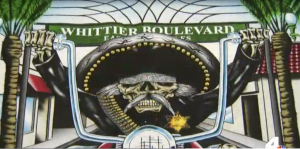The long anticipated report on the deputy gangs inside the Los Angeles County Sheriff’s Department was released on Friday, Sept. 10. And it has a lot to say.
The 230-page report by the nonprofit RAND Corporation was commissioned by the LA County Board of Supervisors, who are fed up with the deputy gang issue, and it contains a list of interesting conclusions about what needs to be done about the problem of deputy cliques that has plagued the nations largest sheriff’s agency for approximately half century.
“At their worst,” the authors write, these “sub-groups encourage violence, undermine the chain of command, and gravely harm relationships with the communities that LASD is dedicated to serve.”
And, because these deputy gangs/cliques/subgroups have existed for so many decades, the report’s authors admit that efforts to change this deputy subgroup culture will likely be met with “internal resistance.”
Yet, change is essential, according to the report. The “potentially corrosive effect” of these groups on the department itself, and its relationship with the residents of the communities it polices, make action necessary.
“This is a transitional moment in law enforcement in which LASD can begin building an organization for the future that embeds accountability and dedication to 21st-century policing.”
Or not.
“The exclusivity and secrecy of subgroups among some deputies in the L.A. Sheriff’s Department poses several risks and challenges,” said Samuel Peterson, the study’s lead author and a policy researcher at RAND.
“While the department’s leadership has taken initial steps to address the influence of the groups, there needs to be greater consistency among command staff in setting expectations and enforcing policies that discourage the influence of these groups,” according to Peterson.
“It’s important to respond at the first sign of potential problems. When problems are identified, a thorough investigation is critical.”
And such thorough investigations have, thus far, been in short supply. (More on that issue later.)
In the course of their deep-dive research, the RAND team conducted an anonymous survey of the LASD’s roughly 10,000 sworn personnel, receiving responses from 1,608 deputies and supervisors.
The researchers also conducted interviews and focus groups “with 141 community leaders and members of the public.”
Plus 57 additional interviews were conducted with members of the LASD and other county stakeholders.
“Our work provides an organizational perspective about the department’s subgroups that has not been provided in the past,” said lead author Peterson. “This provides a sense of why these groups form,” where the groups fit within the culture of the sheriff’s department, “and the variety of perceptions about the groups within the force.”
Attorney Vincent Miller was among those who has been waiting for the findings of the RAND report.
Miller represents a list of LASD deputies who have filed a detailed civil lawsuit that covers disturbing and highly detailed allegations of assaults, threats, intimidation” and more inflicted on the plaintiffs by members of the Banditos deputy clique that operates out of the LASD’s East Los Angeles Station.
“It confirms our allegations,” Miller said on Friday after the report’s release.
Miller specifically pointed to RAND’s conclusion that the deputy gangs are very likely growing.
Here are some of the report’s key findings.
- Community member interviews indicated that subgroups and problematic behavior associated with them have negatively impacted perceptions of LASD. About 47 percent of LASD survey respondents agreed.
- Combined with the interview findings, the LASD survey findings suggest that, for some parts of LASD, subgroups exhibit features of being a normalized part of the organization.
- About 40 percent of LASD survey respondents agreed that subgroups are more common at high-crime stations (55 percent of those who had been invited to join a subgroup agreed).
- About 40 percent of respondents identified the following criteria for being invited to join a subgroup: being known as a hard worker (91 percent of those who had been invited to join a subgroup), working in challenging environments (86 percent of those invited), socializing with subgroup members (51 percent of those invited), and engaging in specific behaviors, such as being aggressive about making arrests (47 percent of those invited).
- According to 30 percent of respondents and 42 percent of those who were invited to join a subgroup, the groups have codes of conduct and expect members to perform to certain standards. Among these respondents, subgroups are perceived to be a motivational tool.
- Around 15 percent of those who had been invited to join a subgroup agreed that being invited to join a subgroup was associated with behavior that violates LASD policy, while 22 percent of invitees agreed that willingness to look the other way when others engage in improper or unethical behavior was a criterion for being invited.
Supervisor Hilda Solis was among those who had some strong words after the RAND report was released.
“The RAND Institute’s study supports the decades-long, troubling history of deputy gangs in the Los Angeles County Sheriff’s Department,” she said.
“It is unfortunate that due to LASD leadership’s inability and frankly, unwillingness to consistently hold deputies and their respective supervisors accountable, there exists a diminishing relationship between the department and residents.”
Solis also pointed to the high ticket deputy-gang-related settlements, “almost $55 million dollars since 1990,” related to claims involving deputy gangs and its members, she said.
“These precious dollars should have instead been used to serve our communities.”
Later, we’ll have lots more about the report and the critical issues it illuminates.
So, watch this space.

